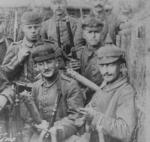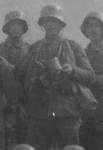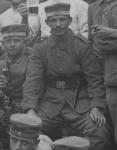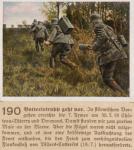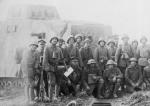
Thomas W
For Deletion-
Posts
788 -
Joined
-
Last visited
-
Days Won
3
Content Type
Profiles
Forums
Blogs
Gallery
Events
Store
Everything posted by Thomas W
-
It's impossible to say if that's a real combat photo or not. The rifleman is totally stock still, which makes him look like he's posing. Also, he's not wearing any equipment. Here's a real combat photo taken at the Haumont Woods, Verdun, on February 21, 1916. In the background is a flamethrower squad of the 16th Company, III. Garde-Pionier-Bataillon. Handwriting on the front of the photo says it was taken at 5:00 P.M.
-
Nope. That, my friend, is a crewman of A7V Tank 501 "Gretchen." He's training in Stosstrupp tactics at Beuville, under the tutelage of Sturmbataillon Nr. 5 (Rohr). It's the only photo I've ever seen of a tanker wearing grenade bags. His shoulder strap is light gray, with a red "K" on it. I won't post the rest of the photo, because it's in my book that Schiffer is about to publish, but the tanker sitting in front of this guy has an "S" for Stosstrupp on his upper left sleeve. I knew that tankers were trained as shock troops, but it's nice to finally have photographic evidence of it.
-
You may be right. On the other hand, these men have no ammunition pouches. They appear to be carrying their bullets in their tunic pockets, which is another reason I identified them as assault troops. Armbands, bullets in pockets, the use of the word Patrouile, and the fact that they're from two, possibly three different companies indicates to me that they're part of an assault unit. Whether it was an actual assault unit or simply one set up because everyone else was creating them, it's impossible to say.
-
They're from different companies, and the writing on the back identified them as being a Patrouille, an early term for an assault unit. It's unlikely that men from different companies would pose together, patrol together, or all wear mourning brassards at the same time. I think the sleeve brassards are green or red, the colors used to identify assault troops according to Anleitung für Kompagnieführer (K.F.U.). Berlin: Reichsdruckerei, 1917. Keep in mind that many of the "assault" units of the Landsturm never saw action. They formed the units because it was the trendy thing to do, and Sturmtrupps had a lot of prestige.
-
Don't forget that in the background is a Doppelkleif or double Kleif comprised of two mittlere Flammenwerfer (Kleif) M.1917. You can see the 1.5 m hose and the 3 m hose attached to the 1.5m Grosse Strahlrohr or large lance. The double Kleif was used when a Grof could not be moved forward. Between the Kleif M.1914 and Wex is a Kleif M.1917. The oil can next to the nitrogen bottle has two kleine Zünder or small igniters lying on the top. Here's the Kleif M.1916. It's different from the M.1917 in that it has three short legs, and the propellant line is on the left side. Note the construction of the oil tank; it's made of two rings and two semi-spherical caps welded together instead of being one continuous cylinder of metal.
-
This well-known image has been used in many English-language books, labeled as "stormtroopers." As you can see, it's actually a Batterietrupp. Note that the second man in the column is equipped with grenade bags, while the last man has a trench dagger. They appear to be wearing the leather gaiters of the artillery, since they're brown rather than black, and some may have leather reinforcements on the inner surface of their trousers.
-
The German term is Batterietrupp. They were trained in shock tactics and hand-grenade combat, because their job was to carry out reconnaissance for field-artillery batteries. They often ran into the enemy and engaged him at close quarters. That's why men of Batterietrupps were armed with trench daggers, the symbol of shock troops. From Vocabulary of German Military Terms and Abbreviations, U.S. Army War College, 1917:
-
I thought of that, but the writing on the back identifies the men as belonging to a Patrouille, which was an early term for assault unit. The earliest assault units wore brassards on the left arm to identify them from regular soldiers. It's always hard to be sure of colors in monochromatic photos, of course, but the hue of the brassards doesn't appear to be that dark, and the men are from different companies. It wasn't often that men of an entire battalion would wear mourning brassards.
-
So, in English: "I send you the best greetings and communicate to you that I am since 10th of the month in the homeland in the collective(?) hospital St. Ottilien in Upper Bavaria, in the hope that my card finds you in the best of health, I remain your Vizefeldwebel Jörg _________" Thanks, guys. I appreciate it.



